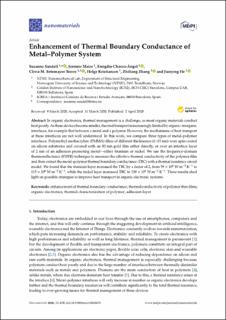| dc.contributor.author | Sandell, Susanne | |
| dc.contributor.author | Maire, Jeremie | |
| dc.contributor.author | Chavez-Angel, Emigdio | |
| dc.contributor.author | Sotomayor Torres, Clivia M. | |
| dc.contributor.author | Kristiansen, Helge | |
| dc.contributor.author | Zhang, Zhiliang | |
| dc.contributor.author | He, Jianying | |
| dc.date.accessioned | 2020-05-13T12:05:49Z | |
| dc.date.available | 2020-05-13T12:05:49Z | |
| dc.date.created | 2020-04-03T12:11:31Z | |
| dc.date.issued | 2020 | |
| dc.identifier.issn | 2079-4991 | |
| dc.identifier.uri | https://hdl.handle.net/11250/2654257 | |
| dc.description.abstract | In organic electronics, thermal management is a challenge, as most organic materials conduct heat poorly. As these devices become smaller, thermal transport is increasingly limited by organic–inorganic interfaces, for example that between a metal and a polymer. However, the mechanisms of heat transport at these interfaces are not well understood. In this work, we compare three types of metal–polymer interfaces. Polymethyl methacrylate (PMMA) films of different thicknesses (1–15 nm) were spin-coated on silicon substrates and covered with an 80 nm gold film either directly, or over an interface layer of 2 nm of an adhesion promoting metal—either titanium or nickel. We use the frequency-domain thermoreflectance (FDTR) technique to measure the effective thermal conductivity of the polymer film and then extract the metal–polymer thermal boundary conductance (TBC) with a thermal resistance circuit model. We found that the titanium layer increased the TBC by a factor of 2, from 59 × 106 W·m−2·K−1 to 115 × 106 W·m−2·K−1, while the nickel layer increased TBC to 139 × 106 W·m−2·K−1. These results shed light on possible strategies to improve heat transport in organic electronic systems. | en_US |
| dc.language.iso | eng | en_US |
| dc.publisher | MDPI | en_US |
| dc.rights | Navngivelse 4.0 Internasjonal | * |
| dc.rights.uri | http://creativecommons.org/licenses/by/4.0/deed.no | * |
| dc.title | Enhancement of Thermal Boundary Conductance of Metal–Polymer System | en_US |
| dc.type | Peer reviewed | en_US |
| dc.type | Journal article | en_US |
| dc.description.version | publishedVersion | en_US |
| dc.source.volume | 10 | en_US |
| dc.source.journal | Nanomaterials | en_US |
| dc.source.issue | 4 | en_US |
| dc.identifier.doi | 10.3390/nano10040670 | |
| dc.identifier.cristin | 1805186 | |
| dc.relation.project | Norges forskningsråd: 245963 | en_US |
| dc.relation.project | Norges forskningsråd: 251068 | en_US |
| dc.description.localcode | © 2020 by the authors. Licensee MDPI, Basel, Switzerland. This article is an open access article distributed under the terms and conditions of the Creative Commons Attribution (CC BY) license (http://creativecommons.org/licenses/by/4.0/). | en_US |
| cristin.ispublished | true | |
| cristin.fulltext | postprint | |
| cristin.fulltext | original | |
| cristin.qualitycode | 1 | |

